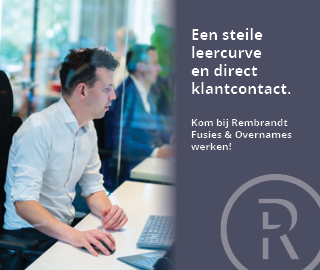Are you curious about what it’s like to work for Rembrandt? In this article Felix talks about his experiences and why he chose Rembrandt!

For the Dutch version, click here.
My name is Tim Foesenek. I grew up in Rijsbergen and have lived in Tilburg since the beginning of my student days, where I have continued to live ever since. After completing the masters in Finance and Supply Chain Management, I started working at Rembrandt M&A (after traveling for a month).
Initially, I had never looked into M&A specifically. Towards the end of my studies it started to become somewhat clear which aspects I found interesting. Figures is an important one of these, but in doing so I wanted to be in contact with the business world. After many introductory meetings with different types of companies (including corporates, the big 4 and smaller business service providers), it turned out that M&A suited my preferences very well , because of the dynamic work and the combination of business and personal aspects. I started to look into this further and it turned out that M&A in the midmarket appealed to me the most, as it involves a lot of contact with clients.
Rembrandt is a big player in this market. With 45 employees it is a small company, but within this specialized market you are one of the largest with such a group. The culture, working methods and training appealed to me the most.
Although it is often said that you only really start learning in practice, I still use a lot of knowledge I gained during my Master’s in Finance. General knowledge about balance sheets, results and cash flow comes back daily. Subjects like Corporate Governance & Restructuring and Corporate Valuation even show directly what some of our work involves. The more quantitative subjects come back less, but have shown me how the market views risk thinking. That helps when there is a financial buyer candidate, for example. In addition, it is also common to work with negotiated options, so knowledge about these types of aspects comes in handy.
Rembrandt’s role can best be summarized as process support for mergers and acquisitions. In the majority of our assignments we are on the sales side, where we can guide and advise our clients from preparation to closing.
The preparation phase consists of valuing the company. This helps us get a good feel for the business and also gives the sellers an indication of the value. Based on this, if the client decides to pursue the process, we prepare an information memorandum and start identifying potential candidates. Once we start approaching candidates, the sales phase has begun. In it, we maintain contact with candidates, coordinate contracts and often conduct negotiations. This phase is very challenging both in terms of content and planning.
As a consultant, I work with a manager and possibly a second consultant on a potential transaction. In the preparation phase, I take on most of the work and often spar with the manager about my progress and questions I have. In the sales phase, we work more closely together. In this, my role varies per project, but I am involved in every phase and also get a lot of space to make an active contribution.
Typically, I have about 5 active projects as well as several projects that are in the preparation phase or temporarily paused.
The most positive thing is the variety and dynamics my job brings me every week. I talk to a lot of people and almost every project has one or (many) more surprising twists and turns. Very challenging, but this makes me go home feeling fulfilled. Besides the content, there is also a lot of challenge on a personal level. I communicate with many different people with diverse backgrounds. And although we often share positive news, of course it sometimes happens that the client had different expectations. It can be tough to deal with this, but these are the moments when I develop myself and learn a lot.
The steps of the process largely match my initial assessment. During my first year, I found out a few things that are a little different in practice. For example, the negotiations are often less hands-off than I thought and are usually based on good substantiation. This makes it interesting, because in that case I can have a big impact with my preparations. By the way, this does not exclude the occasional heated negotiations.
Working in the office is also much more fun than I had envisioned. We are all in an open space, so you get a good sense of what everyone is doing. We make a lot of phone calls, so you often hear challenging conversations from colleagues, which I learn a lot from. In addition, it is very nice to be able to ask a quick question and it is fun to help others.
Rembrandt has both the advantages of a large and a small company. With 45 colleagues there is an incredible amount of knowledge and experience in house and you get to know many interesting people internally. In addition, we are part of Rabobank and have the advantages of a large, professional organization. At the same time, Rembrandt is small enough for you to know everyone and be able to keep up with what is happening within the organization.
The culture is accordingly. Everyone is very ambitious and professional and this goes very well together with fun, interest and humor. We do fun activities together, but it is also paramount at Rembrandt that everyone has enough time for their own friends, hobbies and interests.


Are you curious about what it’s like to work for Rembrandt? In this article Felix talks about his experiences and why he chose Rembrandt!

In this ‘Working At…’, Maxim van den Akker describes his studentlife, his jobsearch, and his choice for and experiences at Fagro.

What is life like after graduating university? Jeroen Florissen tells everything about his experience at Fagro!

Fagro attaches great value to the personal development of the consultant. Are you interested in working at this company? Read their Working At here!